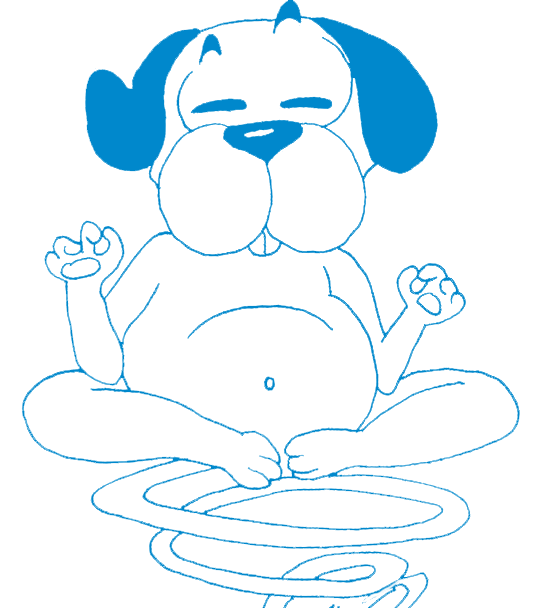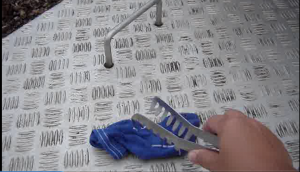What is it?
The idea is to offer our dogs the opportunity to use their nose to find an object marked with a specific scent, among other objects (identical or visually different).
What do we need?
- An object marked by a scent that our dog likes,
- Other objects with neutral scents,
- A spaghetti tongs or any other tool to move objects without leaving our scent,
- Treats that our dog enjoys.
Description and progression
For the game described below, let’s assume that we have 4 identical socks, which we have washed (use the most neutral products possible and avoid strong perfumes) in order to get rid of any unwanted odours. One of them will be marked with our scent, the 3 others will remain as neutral as possible.
Step 1: Let’s settle down in a quiet room in the house (in which he feels comfortable). Let’s start by getting our dog interested in the sock that bears our scent. After having kneaded the sock in our hands for 4 to 5 seconds (if it takes too long, our dog may become impatient and leave us with our sock), we put it on the floor, in front of our dog. As soon as he is interested in it (looks at it, approaches it, sniffs it, touches it with his muzzle or paw, takes it in the mouth,…), he receives a reward. We start again until our dog is systematically interested in the sock, and in the most committed way (each dog will naturally offer a mark: touching it with his paw, staring at it while barking or picking it up, for example). If we want our dog to mark his find in a specific way (for example by barking), we will teach him this behaviour during specific play sessions.
![]() Video: Mark of interest for the object
Video: Mark of interest for the object
Step 2: In the same room in the house, insert a second sock. To prevent the “neutral” sock from catching our scent, we can handle it with a spaghetti tongs or after putting on a glove, for example. We place it clearly visible on the floor, about 20 centimetres from the first sock. We can also refresh the smell of the first sock by holding it in our hands for 1 to 2 seconds. Our dog receives a reward for each mark of interest in the “right” sock, the one that bears the scent of our hands. If our dog gets the wrong sock, we do not react (no sighing, laughing, gesture,…). Let’s remain impassive to wrong choices.
|
|
|
Step 3: In the same room in the house, put a third sock (“neutral” odour) about 20 centimetres away from the other 2 socks. Our dog receives a reward for each mark of interest in the “right” sock. Let’s ignore wrong suggestions. We will take care to move the 3 socks using the spaghetti tongs, in a random sequence. If we systematically put the “right” sock down first or systematically last, our dog will quickly learn that it is a question of selecting the first or last object put down, without making the link with the smell (or lack of smell) of this object.
Only one parameter changes between two stages of the exercise: either the number of objects or the environment.
Step 4: Let’s try a change of location, the garden for example. Our dog receives a reward for each mark of interest in the “right” sock and let’s continue to ignore the wrong suggestions.
When a new parameter causes great difficulty (change of environment for example), we can decrease the level of difficulty of one of the other parameters (go back to 2 socks: one scented and one neutral).
![]() Video: 2 socks in the garden
Video: 2 socks in the garden
![]() Video: 2 glasses with spices in the garden
Video: 2 glasses with spices in the garden
Step 5: Keep increasing the number of socks.
![]() Video: 3 socks
Video: 3 socks
![]() Video: 4 socks
Video: 4 socks
Next steps: Start again from the step 1… with new objects and other odours.
Are our dogs were able to find a tissue scented with paprika, among other tissues scented with salt, cinnamon or thyme? Or find a garment freshly marked with our smell in the middle of other clothes also marked with our smell, but older? Of course they can!
|
|
|
Learning without pressure
These game sessions must be very short (less than 5 minutes and a maximum of 3 sessions during the day). Each session involves reflection and scent work which require a lot of concentration from our dog. If the session is too long or if we repeat too many sessions on the same day, we risk failure. It is better to stop on a positive note, even if it seems to us that the last game we played was very easy to do. Beginners need time to develop their skills as they go along. And let’s not forget that learning takes place optimally when the dog is not stressed and therefore not put under pressure.
In the same vein, there is no need to “motivate” our dog by repeating the request (“search” for example). While our dog is focused on selecting the scent to be found, he mainly uses his sense of smell. Repetitions of “search”, “search”, “search” distract him and overwhelm his ears and brain with useless information. It is only distraction, not motivation.
Beware of “false” scent clues! For example, in a game where the goal is to find an object that we have marked with our own scent, it is important that the other objects DO NOT carry our scent. If we hold objects in our hands, even with our fingertips, we leave olfactory marks that could lead to confusion.
Beware of gestural clues! For example, we should always avoid depositing the “right” object last. Our dog will quickly understand that the last object is the right object, and he will no longer see the need to use his sense of smell.
We should not help them too much, for example, by pointing to the location of the object to be selected. Staring at the object and turning completely towards it are already important indications. The game is for our dogs to develop their olfactory skills, it is not a game of speed or performance. When our dog stops searching, the game is over, either temporarily because a few moments of rest will be enough for him, or permanently depending on our dog. Let’s respect his learning pace.
Let’s also respect his recovery pace: a busy weekend means a greater need for rest. The ideal is then to offer our dog an easier search game: a few treats scattered, without hiding them, at home or on the lawn will do the trick (see “treat search“).
Those who do not cope
If our dog is not interested in this game, we must ask the question: does he like the treats we offer him as a reward? It is up to us to offer him treats that live up to his expectations.
If our dog is not interested in the object, let’s ask ourselves how we can make it more interesting. With socks, for example, we can hide a few treats inside and tie the end. It’s up to us to offer him an interesting and attractive object.
If our dog likes these treats and the object but he is not interested in looking for it, it is probably because it is too difficult for him (physically if our dog is old, sick or injured / emotionally if our dog is not comfortable in the environment for example / if we have skipped steps in the learning progression). It is up to us to offer them a game that matches their physical and/or emotional abilities.
Some dogs could also accept playing with certain objects but not with others: metal keys for example are not very pleasant to play with.
On the other hand, if our dog likes the object “too much”, he will keep it for himself and will not give it back. For later game sessions, let’s use material that our dog doesn’t like too much. We can also teach him to give on request during specific play sessions.
If our dog makes a lot of mistakes, let’s check that we have not introduced an unwanted smell on the objects used. If the game consists of selecting an object that bears our scent, haven’t we accidentally contaminated the other objects with our scent or the scent of the rewards? Let’s take a pile of clothes bearing the scent of the same person, and ask our dog to find a sock with a fresher smell. A seasoned dog will be able to solve this game, but not a beginner dog.
TAKEAWAY
- Offer treats that our dog likes;
- Offer an object that our dog likes;
- Increase the difficulty, step by step;
- Offer learning without pressure;
- Short sessions are a must;
- Offer a game adapted to our dog’s needs, expectations and abilities;
- Watch out for unwanted scents.


